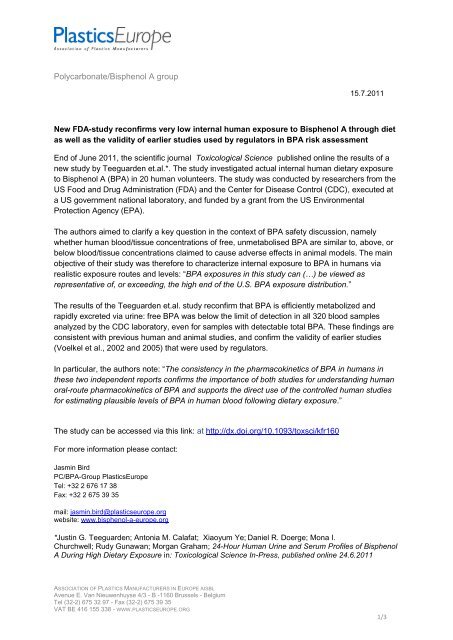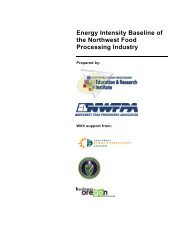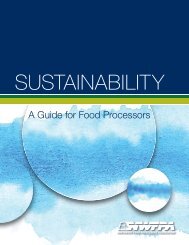You also want an ePaper? Increase the reach of your titles
YUMPU automatically turns print PDFs into web optimized ePapers that Google loves.
Polycarbonate/<strong>Bisphenol</strong> A group<br />
15.7.2011<br />
New FDA-study reconfirms very low internal human exposure to <strong>Bisphenol</strong> A through diet<br />
as well as the validity of earlier studies used by regulators in BPA risk assessment<br />
End of June 2011, the scientific journal Toxicological Science published online the results of a<br />
new study by Teeguarden et.al.*. The study investigated actual internal human dietary exposure<br />
to <strong>Bisphenol</strong> A (BPA) in 20 human volunteers. The study was conducted by researchers from the<br />
US Food and Drug Administration (FDA) and the Center for Disease Control (CDC), executed at<br />
a US government national laboratory, and funded by a grant from the US Environmental<br />
Protection Agency (EPA).<br />
The authors aimed to clarify a key question in the context of BPA safety discussion, namely<br />
whether human blood/tissue concentrations of free, unmetabolised BPA are similar to, above, or<br />
below blood/tissue concentrations claimed to cause adverse effects in animal models. The main<br />
objective of their study was therefore to characterize internal exposure to BPA in humans via<br />
realistic exposure routes and levels: “BPA exposures in this study can (…) be viewed as<br />
representative of, or exceeding, the high end of the U.S. BPA exposure distribution.”<br />
The results of the Teeguarden et.al. study reconfirm that BPA is efficiently metabolized and<br />
rapidly excreted via urine: free BPA was below the limit of detection in all 320 blood samples<br />
analyzed by the CDC laboratory, even for samples with detectable total BPA. These findings are<br />
consistent with previous human and animal studies, and confirm the validity of earlier studies<br />
(Voelkel et al., 2002 and 2005) that were used by regulators.<br />
In particular, the authors note: “The consistency in the pharmacokinetics of BPA in humans in<br />
these two independent reports confirms the importance of both studies for understanding human<br />
oral-route pharmacokinetics of BPA and supports the direct use of the controlled human studies<br />
for estimating plausible levels of BPA in human blood following dietary exposure.”<br />
The study can be accessed via this link: at http://dx.doi.org/10.1093/toxsci/kfr160<br />
For more information please contact:<br />
Jasmin Bird<br />
PC/BPA-Group PlasticsEurope<br />
Tel: +32 2 676 17 38<br />
Fax: +32 2 675 39 35<br />
mail: jasmin.bird@plasticseurope.org<br />
website: www.bisphenol-a-europe.org<br />
*Justin G. Teeguarden; Antonia M. Calafat; Xiaoyum Ye; Daniel R. Doerge; Mona I.<br />
Churchwell; Rudy Gunawan; Morgan Graham; 24-Hour Human Urine and Serum Profiles of <strong>Bisphenol</strong><br />
A During High Dietary Exposure in: Toxicological Science In-Press, published online 24.6.2011<br />
ASSOCIATION OF PLASTICS MANUFACTURERS IN EUROPE AISBL<br />
Avenue E. Van Nieuwenhuyse 4/3 - B -1160 Brussels - Belgium<br />
Tel (32-2) 675 32 97 - Fax (32-2) 675 39 35<br />
VAT BE 416 155 338 - WWW.PLASTICSEUROPE.ORG<br />
1/3
Background information<br />
Issue addressed in the study<br />
Several large-scale urine biomonitoring studies have consistently demonstrated that human exposure<br />
to BPA, from all sources, is extremely low with typical intake in the range of 25-50 nanograms/kg<br />
bodyweight/day. These levels are more than 1,000 times below the safe intake limit (tolerable daily<br />
intake, TDI) set by the European Food Safety Authority EFSA. Other studies, including several<br />
controlled human volunteer studies, have shown that BPA is efficiently metabolized and rapidly<br />
excreted in urine. Taken together, these studies provide a consistent and coherent understanding of<br />
human exposure and metabolism.<br />
In contrast, a number of smaller scale studies have reported significant levels of free (unmetabolized)<br />
BPA in human blood. The levels reported are highly inconsistent with what is known about human<br />
exposure and metabolism from the studies mentioned above. In addition, the validity of the data in<br />
these blood biomonitoring studies is uncertain since other studies have suggested that sample<br />
contamination may be a significant problem in trace level BPA analyses. Nevertheless, these studies<br />
are used as evidence that people are exposed to high levels of BPA, with some claims that human<br />
exposure is even higher than the TDI.<br />
It was an objective of the Teeguarden-research team to contribute to understanding which of these<br />
two sets of study data is valid.<br />
What was done?<br />
In the study, 20 human volunteers ate 3 meals in a day that were enriched in canned foods and<br />
beverages to ensure that the participants were exposed to BPA. Based on how much total BPA was<br />
found in urine, it was determined that the average exposure for all participants was 21% greater than<br />
the 95 th percentile exposure determined by CDC’s population-scale urine biomonitoring data.<br />
Blood and urine samples were collected from each participant hourly during the day of the study. The<br />
blood samples were analyzed for both free BPA and total BPA, while urine samples were analyzed for<br />
total BPA (previous data has shown that free BPA is not commonly found in urine), all with a sensitive<br />
analytical method. This comprehensive set of data allows for a detailed analysis of the<br />
pharmacokinetics of BPA.<br />
Key Results<br />
Total BPA was detected in only 14% of the 320 blood samples, only one of which was above 1 ppb.<br />
Total BPA was below the sensitive limit of detection (0.3 ppb) for 86% of the samples.<br />
Importantly, free BPA was below the limit of detection in all 320 blood samples analyzed by the CDC<br />
lab, even for samples with detectable total BPA. Based on their results the authors note that reported<br />
high levels of BPA in blood are unlikely to be valid: “Furthermore, the current results obtained using<br />
analytical methodology 10-45 times more sensitive than the previous human study by Voelkel et al.<br />
suggest that reported BPA concentrations in human blood of 1.4-19.2 nM [~0.3-4.4 ppb] (Vandenberg,<br />
Chahoud et al. 2010) are highly unlikely in the general population exposed orally to amounts as much<br />
as ~4 times greater than the 95 th upper percentile of aggregate exposure in the general U.S.<br />
population.”<br />
ASSOCIATION OF PLASTICS MANUFACTURERS IN EUROPE AISBL<br />
Avenue E. Van Nieuwenhuyse 4/3 - B -1160 Brussels - Belgium<br />
Tel (32-2) 675 32 97 - Fax (32-2) 675 39 35<br />
VAT BE 416 155 338 - WWW.PLASTICSEUROPE.ORG<br />
2/3
Samples with detectable total BPA were further analyzed in the FDA lab to confirm the findings. Very<br />
low but detectable levels of free BPA were found in 3 of these samples, but further analysis revealed<br />
that contamination was most likely the source of the free BPA. The authors note, “the evidence<br />
presented here and elsewhere for low-level contamination (Markham et al., 2010; Twaddle et al.,<br />
2010), even in the face of extraordinary attention to this problem, suggests that these infrequent<br />
positive determinations near the detection limit should be suspect” and “Thus, some attributions of<br />
high blood BPA concentrations from oral exposure seem implausible.”<br />
ASSOCIATION OF PLASTICS MANUFACTURERS IN EUROPE AISBL<br />
Avenue E. Van Nieuwenhuyse 4/3 - B -1160 Brussels - Belgium<br />
Tel (32-2) 675 32 97 - Fax (32-2) 675 39 35<br />
VAT BE 416 155 338 - WWW.PLASTICSEUROPE.ORG<br />
3/3

















